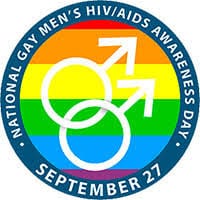 Today is National Gay Men’s HIV/AIDS Awareness Day.
Today is National Gay Men’s HIV/AIDS Awareness Day.
Not long ago, such a statement would have carried an immensely heavy and somber weight. But in 2018, the conversation around HIV/AIDS is more about prevention, treatment, and continuing care than it is about fear and death. HIV experts and policymakers have even begun to talk about an end to HIV epidemic in the US.
There has been important progress made in reducing the HIV epidemic in the US. The rate of new infections decreased 18% from 2008 to 2014, and pre-exposure prophylaxis (PrEP) is being prescribed and utilized as a significant HIV prevention method. Moreover, we know that undetectable equals untransmittable (U = U), which means that a person living with HIV who maintains viral suppression cannot transmit HIV sexually. However, progress has not been achieved equally across all groups at risk for HIV. Gay and bisexual men and transgender women, especially those who are Black and Latinx, continue to be disproportionately impacted.
National Gay Men’s HIV/AIDS Awareness Day was created in 2008 by the National Association of People with AIDS to recognize the disproportionate impact of HIV on gay and bisexual men. The day represents an opportunity to mobilize members of the LGBT communities to learn their HIV status and make decisions to live healthy lives, regardless of their HIV status. It is a day to emphasize the need to work toward ensuring equitable access for those impacted most, utilizing powerful tools to end new infections, and encouraging dialogue around testing, prevention, and adherence to care.
Recent data from the Centers for Disease Control and Prevention (CDC) shows that 67% of new HIV diagnoses were among gay and bisexual men in 2016. And while the overall rate of new diagnoses is falling, racial disparities remain. Between 2011 and 2015, the rate of new HIV diagnoses increased 13% for Latino gay and bisexual men and 30% for Black gay and bisexual men aged 25 to 34. 1 in 6 gay and bisexual men living with HIV are undiagnosed and unaware they are HIV positive. Furthermore, PrEP may not be reaching Black and Latinx communities who need it most. Despite 90,000 prescriptions for PrEP being filled from September 2015 to August 2016, only 7,600 prescriptions were filled for nearly the 300,000 Latinx individuals who could benefit from PrEP and just 7,000 prescriptions were filled for the approximately 500,000 Black individuals who could benefit from PrEP. And even though U = U is a great breakthrough that reinforces the benefits of antiretroviral therapy and viral suppression for people living with HIV and for public health, Black and Latino gay and bisexual men are much less likely to achieve viral suppression than white gay and bisexual men. Initiatives to combat such inequities and increase medical, sexual education, and broader health access are necessary to ending the HIV epidemic and ensuring healthy lives for gay and bisexual men.
In April, the O’Neill Institute for National and Global Health Law produced a report for NMAC, Expanding Access to Biomedical HIV Prevention, which specifically proposes recommendations for tackling barriers Black and Latino gay and bisexual men and other communities of color face. Such recommendations include: strengthening healthcare infrastructure, increasing community campaigns promoting awareness of biomedical HIV prevention tools, training providers to better navigate across cultures to provide effective HIV treatment and prevention, increasing representation of LGBT people of color in the clinical workforce, centering voices of undocumented Latinx, and many more. The O’Neill Institute’s Infectious Diseases Initiative continues to work on the overall education of policymakers, community members, and advocates to support HIV prevention and care.
Today is National Gay Men’s HIV/AIDS Awareness Day. We must continue to make progress. Let’s refocus and redouble our efforts to address the HIV and health needs of all gay and bisexual men and the LGBT community. Black and Latino gay and bisexual men must not be left behind.
This blog post was co-authored by Airin Chen, a second-year law student at Georgetown Law and a research assistant at the O’Neill Institute.



